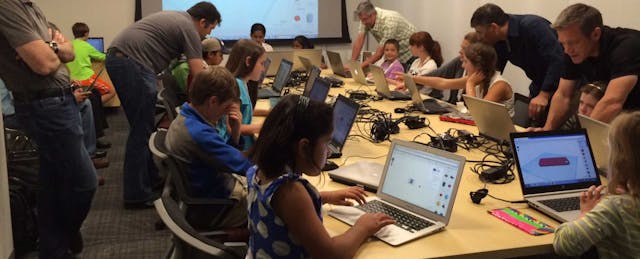I remember when my husband started coaching the JV basketball team at a local high school in Richmond, CA. He had a passion for sports and loved working with kids. Sitting in the stands during the first game, I beamed as I watched him interact with the students. He seemed to shine.
On the car ride home, we both knew; he was destined to be a teacher. Not just on the court, but also in the classroom.
He left a career in finance and went back to school to obtain his teaching credential. He landed a job teaching 8th grade US History to the amazing kids at Helms Middle School in San Pablo, CA. He had found his calling. Little did I know that I too would soon be in the classroom.
My husband knows that I work for a software company that does stuff with 3D printing and that we get free tickets to Maker Faire, but that’s usually the extent of his interest in my profession. So I was shocked when he asked me to be a guest speaker in his class that first year.
While planning my first lesson for his students, I asked myself, “What should I do?” How do I integrate design, modeling and 3D printing into 8th grade US history? I consulted my friends from Make magazine, read the local maker teacher blogs and thought I was ready to go. But a funny thing happened during my first period lesson: I kinda failed. The end result, however, was better than I ever expected.
I had planned to show the kids how to draw relevant historical monuments in SketchBook and then create 3D models in Tinkercad, followed by an overview of 3D printing. But in true maker fashion, the students had ideas of their own. After nodding politely to their teacher’s wife, they got to work. They started talking to each other, helping each other, laughing at each other. I stood back next to my husband and tried to lend a hand where I could, but I was not really needed. The kids were doing it themselves.
At the end of the class, I asked the students how they felt about what they’d just learned. They raised their hands and shouted out answers and sought me out to ask more questions. When the bell rang, they thanked me for my time.
My husband immediately started giving me feedback and said, “You know what was interesting about today?”
“What?” I replied.
“The kids that were the most engaged are the ones I can never connect with. They never raise a hand. They never care,” he shared. “Today they cared. Today they asked questions. Today they were engaged.”
That day with my husband’s students showed me firsthand the impact of the maker movement migrating into schools; it’s waking up classrooms, kids and teachers. It’s fun, simple and--most of all-- engaging. And it just might help educators connect with difficult-to-reach students.
Tools for Tinkering
It’s now easier than ever to launch a maker movement in the classroom. At Autodesk, we’re building a community of resources, projects and hardware recommendations to help students design and make projects they can hold in their hands. You can find out more about maker-based learning with Project Ignite, and by exploring the tools and resources below:
- Tinker with Design – If you are looking for a simple and easy design tool, check out Tinkercad. Create a free account, take lessons to learn the basics and you’re set to go. The great thing about this software is that is it browser-based and part of Google Apps for Education.
- Do It in 3D – If your students love Minecraft, introduce them to 3D design and allow them to quickly build out their own worlds using Tinkercad. You’re sure to be teacher of the year! Check out this step-by-step blog for all the details.
- Light It Up – Making isn’t just about 3D design and printing; electronics and the Internet of Things are moving toward center stage. 123D Circuits empowers makers to learn about electronics and bring their ideas to life using free, easy-to-use online tools.
- Join the Movement -Instructables is an online community that supports teachers by providing free pro memberships and helping them share their best plug and play hands-on projects.



